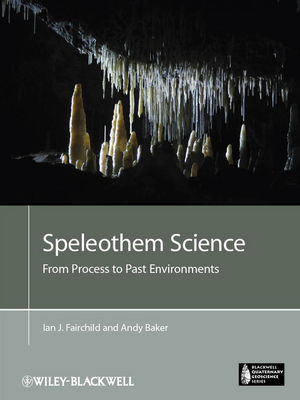
Speleothem Science
Wiley-Blackwell (Verlag)
978-1-4051-9620-8 (ISBN)
- Titel z.Zt. nicht lieferbar
- Versandkostenfrei innerhalb Deutschlands
- Auch auf Rechnung
- Verfügbarkeit in der Filiale vor Ort prüfen
- Artikel merken
Ian Fairchild was originally a geologist, then more specifically a sedimentologist, morphing into a physical geographer with leanings to environmental chemistry, before putting more geology back in the mix. Hence, he is now Professor of Geosystems at the University of Birmingham, UK, researching both on modern environments and interpreting those in deep time, with carbonates, waters and climates as linking themes. Andy Baker was trained as a physical geographer, and worked at the interface of geology, physical geography, and environmental engineering. He is currently a Professor at the University of New South Wales and a chief investigator in Australia’s National Centre for Groundwater Research and Training.
Preface, xi
Acknowledgements, xiii
I Scientifi c and geological context, 1
1 Introduction to speleothems and systems, 3
1.1 What is all the fuss about?, 3
1.2 How is this book organized?, 11
1.3 Concepts and approaches of system science, 13
1.4 The speleothem factory within the karst system, 18
2 Carbonate and karst cave geology, 28
2.1 Carbonates in the Earth system over geological time, 28
2.2 Lithologies of carbonate host rocks, 34
2.3 Carbonate diagenesis and eogenetic karst, 47
2.4 Speleogenesis in mesogenetic and telogenetic karst (with contributions from John Gunn and David J Lowe), 55
2.5 Cave infilling, 64
2.6 Conclusion, 71
3 Surface environments: climate, soil and vegetation, 73
3.1 The modern climate system, 73
3.2 Water isotopes in the atmosphere, 84
3.3 Soils of karst regions, 94
3.4 Vegetation of karst regions, 102
3.5 Synthesis: inputs to the incubator, 104
II Transfer processes in karst, 105
4 The speleothem incubator, 107
4.1 Introduction to speleophysiology, 107
4.2 Physical parameters and fl uid behaviour, 109
4.3 Water movement, 114
4.4 Air circulation, 122
4.5 Heat flux (authored by David Domínguez-Villar), 137
4.6 Synthesis: cave climatologies, 145
5 Inorganic water chemistry, 148
5.1 Sampling protocols for water chemistry, 148
5.2 The carbonate system, 152
5.3 Weathering, trace elements and isotopes, 156
5.4 Carbon isotopes, 173
5.5 Evolution of cave water chemistry: modelling sources and environmental signals, 180
6 Biogeochemistry of karstic environments, 187
6.1 Introduction, 187
6.2 Organic macromolecules, 188
6.3 Pollen and spores, 198
6.4 Cave faunal remains, 199
6.5 Synthesis and research gaps, 200
III Speleothem properties, 205
7 The architecture of speleothems, 207
7.1 Introduction, 207
7.2 Theoretical models of stalagmite growth and of stalagmite and stalactite shapes, 207
7.3 Geometrical classifi cation of speleothems, 213
7.4 Mineralogy and petrology, 223
7.5 Synthesis, 241
8 Geochemistry of speleothems, 245
8.1 Analysis and the sources of uncertainty, 245
8.2 The growth interface, 249
8.3 Trace element partitioning, 255
8.4 Oxygen and carbon isotope fractionation, 263
8.5 Evolution of dripwater and speleothem chemistry along water flowlines, 277
8.6 Process models of variability over time, 281
9 Dating of speleothems, 290
9.1 Introduction, 290
9.2 Dating techniques, 291
9.3 Age–distance models, 300
9.4 Conclusions, 301
IV Palaeoenvironments, 303
10 The instrumental era: calibration and validation of proxy-environment relationships, 305
10.1 Available instrumental and derived series, 306
10.2 Methodologies, 311
10.3 Case studies of calibrated speleothem proxies, 316
10.4 Questions raised and future directions, 323
11 The Holocene epoch: testing the climate and environmental proxies, 324
11.1 A brief overview of the Holocene, 325
11.2 The past millennium, 327
11.3 Holocene environmental changes: speleothem responses, 334
11.4 Questions raised and future directions, 351
12 The Pleistocene and beyond, 353
12.1 Pleistocene proxy records (ice-age climate fl uctuations defined and drawn), 353
12.2 Insights into pre-Quaternary palaeoenvironments, 361
12.3 Questions raised and looking to the future, 365
APPENDIX 1 Archiving speleothems and speleothem data, 368
References, 371
Index, 421
| Erscheint lt. Verlag | 10.4.2012 |
|---|---|
| Reihe/Serie | Blackwell Quaternary Geoscience Series |
| Verlagsort | Hoboken |
| Sprache | englisch |
| Maße | 191 x 249 mm |
| Gewicht | 1157 g |
| Themenwelt | Naturwissenschaften ► Geowissenschaften ► Geologie |
| ISBN-10 | 1-4051-9620-3 / 1405196203 |
| ISBN-13 | 978-1-4051-9620-8 / 9781405196208 |
| Zustand | Neuware |
| Haben Sie eine Frage zum Produkt? |
aus dem Bereich


